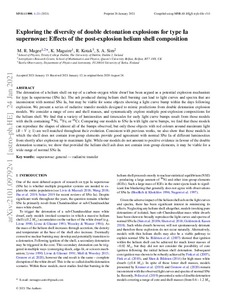Exploring the diversity of double-detonation explosions for Type Ia supernovae: effects of the post-explosion helium shell composition
Magee MR; Maguire K; Kotak R; Sim SA
Exploring the diversity of double-detonation explosions for Type Ia supernovae: effects of the post-explosion helium shell composition
Magee MR
Maguire K
Kotak R
Sim SA
OXFORD UNIV PRESS
Julkaisun pysyvä osoite on:
https://urn.fi/URN:NBN:fi-fe2021093048398
https://urn.fi/URN:NBN:fi-fe2021093048398
Tiivistelmä
The detonation of a helium shell on top of a carbon-oxygen white dwarf has been argued as a potential explosion mechanism for Type Ia supernovae (SNe Ia). The ash produced during helium shell burning can lead to light curves and spectra that are inconsistent with normal SNe Ia, but may be viable for some objects showing a light-curve bump within the days following explosion. We present a series of radiative transfer models designed to mimic predictions from double-detonation explosion models. We consider a range of core and shell masses, and systematically explore multiple post-explosion compositions for the helium shell. We find that a variety of luminosities and time-scales for early light-curve bumps result from those models with shells containing Ni-56,Fe- 52, or Cr-48. Comparing our models to SNe Ia with light-curve bumps, we find that these models can reproduce the shapes of almost all of the bumps observed, but only those objects with red colours around maximum light (B - V greater than or similar to 1) are well matched throughout their evolution. Consistent with previous works, we also show that those models in which the shell does not contain iron-group elements provide good agreement with normal SNe Ia of different luminosities from shortly after explosion up to maximum light. While our models do not amount to positive evidence in favour of the double-detonation scenario, we show that provided the helium shell ash does not contain iron-group elements, it may be viable for a wide range of normal SNe Ia.
Kokoelmat
- Rinnakkaistallenteet [27094]
